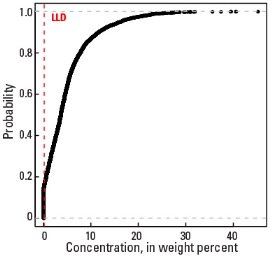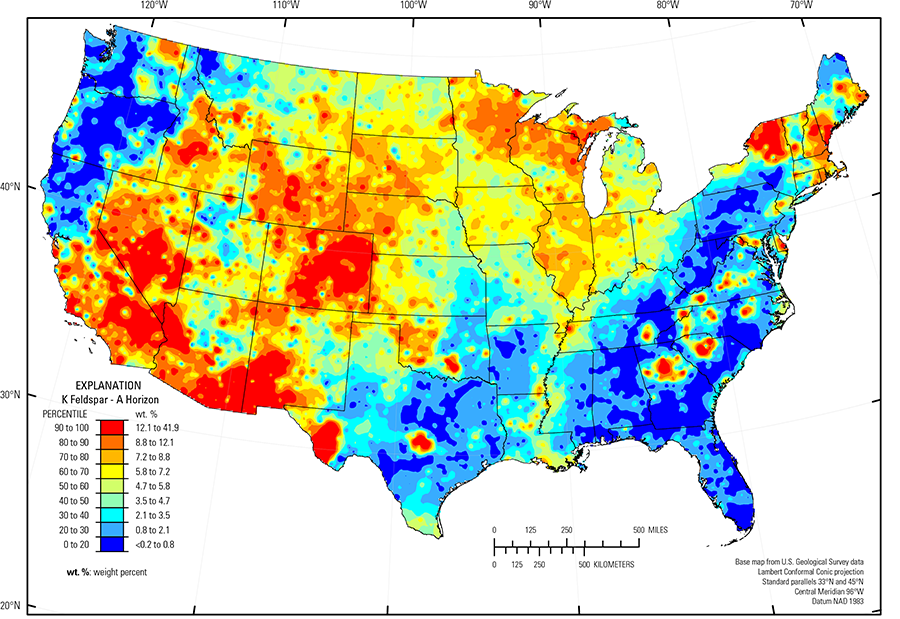
The purpose of these interpretive discussions is to provide a perspective on regional- and national-scale variations in element and mineral distributions in soils and their likely causes. The significant spatial variations shown by most elements and minerals can commonly be attributed to geologic sources in underlying parent materials, but other spatial variations seem clearly related to additional factors such as climate, the age of soils, transported source material, and anthropogenic influences. We attempt to distinguish the influence of these various factors on a regional and national scale. Numerous more local features might similarly be related to these same factors, but these features also have some probability of being an artifact of a random sampling of variable compositions, so that there is some probability of samples with similar compositions occurring in clusters of two or more adjacent sites by chance. Distinguishing such random occurrences from true variability is beyond the scope of the data from which these maps are constructed. Some caution, therefore, is advisable in interpreting the significance of these more local features unless some unique sources or processes can clearly be related to them.
Feldspars are minerals that have limited solid solution among three end members: potassium feldspar (K feldspar), sodium (Na) feldspar, and calcium (Ca) feldspar. Potassium feldspar has an ideal chemical formula of KAlSi3O8, with limited Na substitution for K. Potassium feldspar is a common mineral in alkalic and felsic igneous rocks, such as syenite, granite and rhyolite. Potassium feldspar is stable in metamorphic equivalents, such as schist and gneiss. Sedimentary rocks, such as arkose, as well as unconsolidated materials such as alluvial, eolian, or glacial deposits may also have significant K feldspar. Potassium feldspar in soil is susceptible to weathering, although it weathers more slowly than other types of feldspar. With time in a sufficiently humid climate, K feldspar breaks down and dissolves, with subsequent precipitation of some of its dissolved constituents into clay minerals. Thus, in soil, the distribution of K feldspar is dependent on the presence of the mineral in the initial soil parent material, climate factors, and soil age.
In our data, K feldspar is reported at more than 85 percent of all sites in the conterminous United States, with maximum concentrations greater than 40 weight percent (wt. %) in both the soil A and C horizons. The map patterns for both soil horizons are similar to one another, although the median concentration of K feldspar in the soil A horizon (4.7 wt. %) is higher than the median concentration in the soil C horizon (3.7 wt. %) (see the summary statistics [open in new window]).
Potassium feldspar occurs in soil developed in areas with abundant granite and rhyolite, metamorphic equivalents, as well as unconsolidated alluvial and eolian deposits sourced from similar rocks. Examples of such areas include:
- Parts of the Central and the Southern Rocky Mountains (USDA, 2006) (variety of rock types, including granite);
- Basin and Range (Fenneman and Johnson, 1946) (felsic volcanic rocks and related alluvium);
- Sierra Nevada Mountains and the Central California Coast Range (USDA, 2006) (a variety of rock types, including granite);
- Trans–Pecos volcanics (Schruben and others, 1997), Texas (rhyolite, alkalic volcanic rocks, and related alluvium);
- Llano Basin (Precambrian granitic rocks); and
- Adirondack highlands (Fenneman and Johnson, 1946), northern New York (granites and metamorphic rocks).
High K feldspar in soil of the Colorado Piedmont (Fenneman and Johnson, 1946) reflects the presence of K feldspar originally sourced from the eroding Rocky Mountains to the west, subsequently deposited in eastern Colorado as sandstone or shale and more recent unconsolidated alluvial and eolian sediments. The distribution of K feldspar in soil in the Upper Midwest is controlled by glacial provenance. In this region, melting of glacial ice following late Wisconsinan period advances (16,000 to 12,000 years ago) left the region north of the southern glacial limit (Soller and others, 2012) mantled with a blanket of mixed, immature sediments, from which present–day soil developed. Individual ice lobes (Grimley, 2000) created distinct patterns in soil mineralogy and geochemistry because of varying provenance and ice transport paths. 'Gray' (carbonate– and shale–rich) tills in the James and Des Moines lobes (Grimley, 2000) were derived from Cretaceous sedimentary rocks (dolostone, limestone, and shale). Gray tills were transported significant distances to the south and southeast from their source and deposited in areas underlain by Precambrian bedrock. 'Red' quartz– and feldspar–rich till deposited in northeastern Minnesota, northern Wisconsin, and northwestern Michigan have a Precambrian crystalline rock provenance (Rainy lobe (Grimley, 2000)) and Precambrian red sandstone (with variable quantities of quartz and feldspar) provenance (Superior lobe (Grimley, 2000)). Thus, the concentration of K feldspar is markedly different among the different glacial lobes depending on provenance, with higher K feldspar concentrations in 'red' till compared to 'gray' till.
Soils throughout the Piedmont (Fenneman and Johnson, 1946) are old and have undergone long–term weathering in a humid to semi–humid environment. In some areas with clay–rich and highly leached soils any original K feldspar has largely been dissolved. In scattered areas, such as central Georgia, soil underlain by granite or metamorphosed granite still retains K feldspar.
Other large areas of the conterminous United States with low concentrations of K feldspar in soil had little of the mineral in the bedrock or unconsolidated sediments that were an original source for soil parent materials. These areas (and dominant soil parent materials) include:
- Pacific Northwest and northern California (mafic rocks, including the Columbia River basalt (Swanson and Wright, 1981) and the basalts of the Cascade Range;
- Colorado Plateau (USDA, 2006) (quartz–rich sandstone and eolian deposits);
- Texas carbonate terrane (USDA, 2006) (limestone, dolostone, chalk, and marl);
- Appalachian Plateaus (USDA, 2006) (cyclic beds of sandstone, shale, and coal measures); and
- Gulf and Atlantic Coastal Plain (Fenneman and Johnson, 1946) (sedimentary rocks and unconsolidated sediments).
The Gulf and Atlantic Coastal Plain is bisected by the Southern Mississippi River Alluvium and the Southern Mississippi Valley Loess (USDA, 2006). Alluvial sediments have deposited in the Mississippi River valley as the river has flooded in recent geologic time. When these sediments dried, winds picked up the fine material and deposited it in thick loess sheets, mainly along the east side of the river valley. The youngest loess sheets are about 10,000 years old. A pattern of higher K feldspar in soil developed on these young sediments reflects long–range transport of material from areas containing K feldspar from the upper part of the Mississippi River drainage basin.
Statistics - 0 TO 5 CM
Statistics - A Horizon
| Number of samples | 4,802 |
| LLD | 0.2 wt. % |
| Number below LLD | 686 |
| Minimum | <0.2 wt. % |
| 5 percentile | <0.2 wt. % |
| 25 percentile | 1.4 wt. % |
| 50 percentile | 4.7 wt. % |
| 75 percentile | 8.0 wt. % |
| 95 percentile | 16.4 wt. % |
| Maximum | 41.9 wt. % |
| MAD | |
| Robust CV |
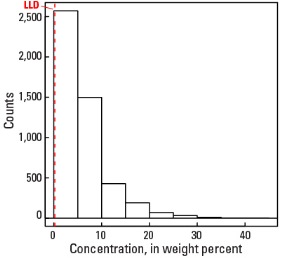
Histogram
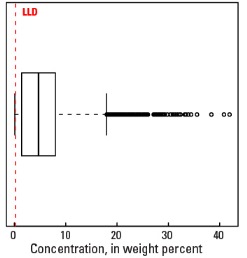
Boxplot
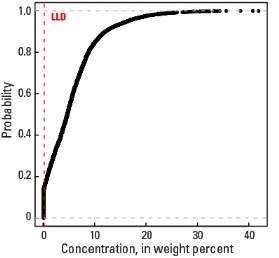
Empirical cumulative distribution function
Statistics - C Horizon
| Number of samples | 4,773 |
| LLD | 0.2 wt. % |
| Number below LLD | 705 |
| Minimum | <0.2 wt. % |
| 5 percentile | <0.2 wt. % |
| 25 percentile | 1.1 wt. % |
| 50 percentile | 3.7 wt. % |
| 75 percentile | 6.6 wt. % |
| 95 percentile | 16.3 wt. % |
| Maximum | 45.2 wt. % |
| MAD | |
| Robust CV |
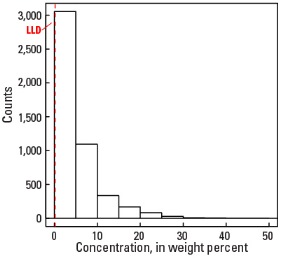
Histogram
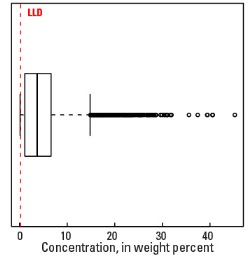
Boxplot
